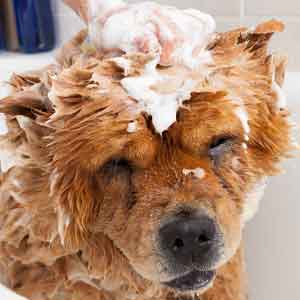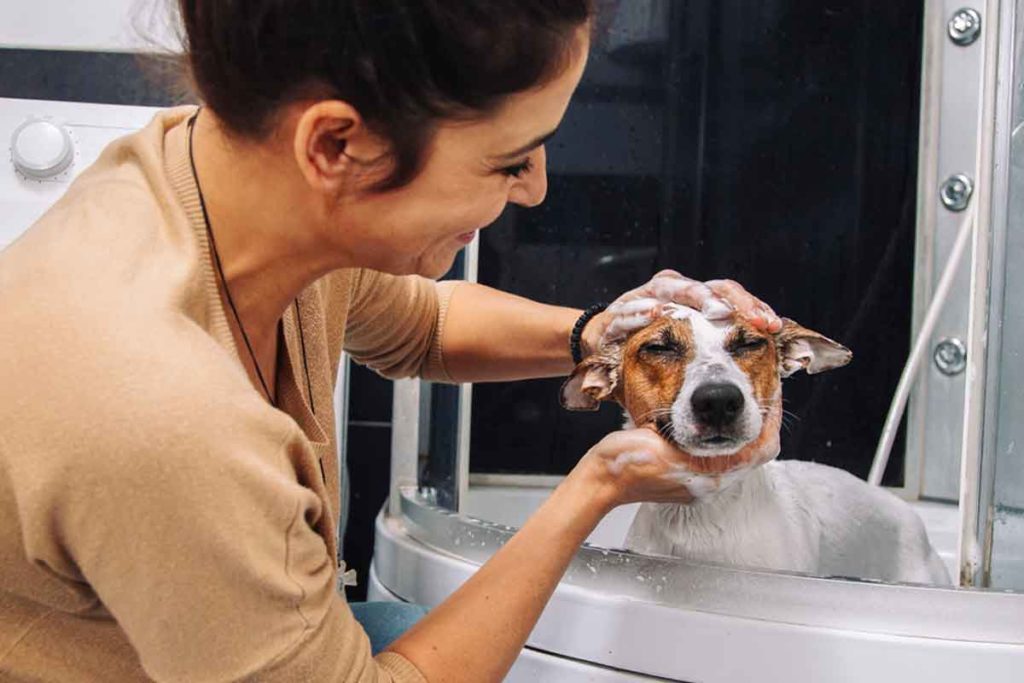Baths are an essential part of your dog’s grooming regimen and are crucial to keeping them feeling—and looking—their best. But while there are reasons to keep your dog regularly bathed, over-bathing can create serious problems for your pup. How do you know how many baths is too many baths? What can you do to support your dog’s health while keeping them clean and smelling fresh??
Table of contents
- Benefits of bathing your dog
- Potential issues with bathing too much
- Determining how frequently to bathe your dog
- Bath time success
Benefits of bathing your dog
Giving your dog regular baths is an essential part of their grooming needs. In some cases, however, dog baths are more for your benefit than your pup’s. A good wash and rinse can remove visible dirt and eliminate odor. Bathing your dog can also help minimize your symptoms from allergies to pet dander. Your dog may have also picked up other environmental allergens like pollen outside.
Appropriate bathing also keeps your dog’s skin and coat healthy, according to the Central California SPCA. Some dogs, like the American Hairless Terrier, should be bathed to prevent oil buildup on their skin. Others, like wrinkly bulldogs, may be prone to smelly and irritating bacterial and fungal infections if not bathed regularly. Bath time is an excellent opportunity for you to check your dog for signs of skin problems, parasites, and lumps that could indicate a more serious health issue.
There are problems with bathing too frequently as well as bathing too infrequently, warn experts from Callaghan Road Animal Hospital. Dog owners should be mindful of the grooming needs of their individual pet.
Potential issues with bathing too much
When it comes to bathing every now and then, there are benefits for both you and your dog. But how do you know how many baths is too many baths? It is important to keep in mind that dogs do not need to bathe as much as people do. In fact, excessive bathing can actually harm your pet.
Too much bathing can strip the natural oils from your dog’s coat, which they need for a healthy coat and skin. Dry, irritated, and itchy skin is not pleasant for your dog. It is also difficult for you to watch your pup in discomfort. Hill’s Pet notes that bathing more than necessary can also result in a dry, dull coat, as well as dandruff.
The natural oil stripping that can occur from over-bathing can be especially problematic for double-coated dog breeds. The Merryfield School of Pet Grooming notes that these oils work to waterproof your dog’s coat, allowing for better insulation against the cold and elements. If you do need to bathe more frequently, Merryfield suggests oatmeal-based dog shampoo or follow up with a moisturizing dog conditioner can help replenish your pet’s natural moisture.
Determining how frequently to bathe your dog
So, how often should you bathe your dog? The answer depends on your dog’s breed and coat, lifestyle and activity level, and health. Many dogs do fine with one bath per month or even every few months. However, every dog is different and has unique grooming needs.
Breed and coat
The ideal frequency of baths can vary by breed and coat. Breeds with an oily coat, like Bassett Hounds, may need to be washed more often than others to prevent oil build-up, according to the American Kennel Club (AKC). This is also true for hairless dogs, who can be bathed as often as once a week. Wrinkly dogs, such as English Bulldogs and Pugs, should be bathed frequently and cleaned daily. This will help avoid itchy skin and infections in the folds of their skin. These dogs should have daily checks of their pads and between their toes as well as in their skin folds, and cleaned as needed. Prescription cleansers may be needed for these breeds.
Generally, International Professional Groomers (IPG) notes that the more hair a dog has, the more work is involved in maintaining their grooming routine, including the frequency of baths. For medium-to-long coats, like those of Malteses and Collies, a bath could be needed between weekly to every six weeks. While brushing can help pull out loose fur from your dog’s coat to prevent the mess of shedding, bathing can really help pull all that loose fur out. If it’s the middle of shedding season, your shedding dog may need more frequent bathing.
Timelines can be even longer for short-haired dogs, who can go up to three months without a bath, according to IPG. Your dog’s coat should always be properly maintained, but particularly during longer periods between baths. It is not typically recommended to bathe your dog any less frequently than every three months.
Lifestyle and activity level
If your dog enjoys the great outdoors and loves diving in the mud and swimming, frequent bathing is probably necessary. A more active, messy lifestyle may be easier with a short-coated dog, suggests Merryfield. Keeping these pups clean between baths, even if they are getting dirty, requires less effort. You can usually get away with giving short-haired dogs a good rub-down with a damp washcloth or wipe made specifically for dogs. During the warmer months, a hose does a great job of getting paws and legs clean without a full bath. Plain water instead of shampoo is a great idea for muddy or sandy dogs, as it will keep your house cleaner without drying out their skin.
Skin health
Dogs with skin conditions or allergies that result in dry, itchy skin typically require more frequent bathing. Regular baths can go a long way towards removing environmental allergens and reducing bacteria and yeast. With the right shampoo and conditioner, giving your dog who has allergies or a skin infection a bath can also moisturize and repair the natural barrier of their skin, according to CCSPCA. If your dog does have any allergies or a skin condition, your vet may recommend a specific shampoo or even prescribe a medicated shampoo.
A healthy dog with a short, smooth coat does not typically need a bath unless they are smelly or especially dirty. Be sure to consult your veterinarian about how often to bathe your dog and what supplies to use. All pets also benefit from regular ear cleaning, nail trimming, and thorough coat brushing.
Is your dog suffering from itchy skin? ElleVet can help!
ElleVet’s CBD + CBDA is proven effective in providing dogs support for itchy skin. We conducted a groundbreaking study in 2020 investigating the efficacy of our CBD + CBDA oil on dogs with pruritus, itchy skin inflammation common in dogs. Results found that the majority of dogs enrolled in the study, who had not previously responded to other commonly used products, had a significant improvement in skin itchiness after using ElleVet’s CBD + CBDA.

If you are noticing excessive itching, ElleVet’s CBD + CBDA products can address this irritation and discomfort and offer skin health support, which is important for maintaining a good quality of life. Pet parents give their dogs our chews, soft gels, and oils to help ease their dog’s discomfort and incessant itching with tremendous success. In addressing these issues, ElleVet’s CBD + CBDA can lead to improved overall well-being. And we all want a happy, healthy pup!
Bath time success

Bathing is an essential component of keeping your dog clean, so it is important to have the right supplies and set up your dog for successful bath times. Here are some tips for making bath time efficient and enjoyable for everyone:
Get ready
- Find the right place to bathe your dog. Consider the size and breed of your dog to ensure you have space to accommodate a bath. Some dogs can bathe in the kitchen sink, others may be better suited to wash off outside.
- Prepare your dog’s coat to prevent any discomfort from tangles and matting. Brush your pup’s coat, especially if they have a longer coat that frequently tangles.
Get the right tools
- Make sure you have everything you need within reach. You don’t want to be chasing a wet dog around your home while you try to find the shampoo.
- Towels – In addition to a towel or two to dry your dog off, you may want to have an extra one for your dog to stand on when they’re still wet.
- Shampoo – Be sure to use a high-quality shampoo made specifically for dogs. Ask your veterinarian or a professional groomer for recommendations. If your dog has a healthy coat and does not have any allergies or skin conditions, you can simply use a gentle, over-the-counter pet shampoo. Human shampoo may be too harsh and can contain fragrances or other ingredients that can irritate your dog’s skin or upset their stomachs if ingested.
- Conditioner – Conditioner can be helpful in rehydrating dogs’ skin. This is particularly important if you bathe your dog frequently or your dog has skin issues.
- Brushes – Use brushes appropriate for your dog’s coat to groom your pup before and after bathing.
- Treats – Some dogs love bath time, but not all pups find the experience enjoyable. Help make baths as comfortable as possible by providing treats or using a lick pad, which attaches to the side of the tub and can be filled with peanut butter to keep them occupied.
Wash (and dry!)
- Fully saturate your dog’s coat with water. Be mindful of water temperature and pressure, especially if bathing outside. Make sure water pressure is low and the water is lukewarm. To prevent moisture from getting trapped, you can consider placing large cotton balls in your dog’s ears.
- Shampoo your dog, taking care to avoid sensitive areas, including their eyes and face. You can use a washcloth on your dog’s face to prevent irritation. You may want to dilute the dog shampoo with water. This will help the shampoo spread and lather more easily. Let the shampoo sit on your dog’s coat for a few minutes, and even consider shampooing twice for extra dirty dogs. IPG notes that during the first wash, shampoo binds with the dirt and helps get rid of it. The second wash cleans the skin and pulls out all the remaining dirt and oil in your dog’s hair.
- Thoroughly wash off all shampoo. Soap residue can irritate your dog’s skin. Your dog may also lick off and ingest remaining shampoo, which can cause stomach upset.
- Drying your dog’s coat after a bath is crucial to keeping your pup healthy and comfortable. Moisture can easily get trapped in the folds of a wrinkly dogs’ skin, so be sure to dry all of those tough-to-reach spots to avoid skin issues. Dogs with heavier coats should also be dried thoroughly to prevent hot spots. You may want to consider using a dog blow dryer, which uses less heat than one made for humans and is less likely to injure your dog. Dryers should not be used, however, on dogs with dry or sensitive skin. Blow drying can further dry out and irritate your dog’s skin.
Determining how often to give your dog a bath depends on your dog’s breed and coat, lifestyle and activity level, and health. While many dogs do fine with monthly or even every few month washes, some need far more, or require special tools and regimens. Be sure to consult your veterinarian and seek guidance from a professional groomer about how and when to bathe your dog. If your dog is itching incessantly, it is time to talk with your veterinarian to find out if there is another issue going on.
Any health or medical information in ElleVet blogs is from a variety of public and reputable sources. This information is intended as an education resource only and is not a substitute for expert professional care.









